Exploring Spatial Variations in the Relationships between Landscape Functions and Human Activities in Suburban Rural Communities: A Case Study in Jiangning District, China
Abstract
:1. Introduction
2. Materials and Methods
2.1. Study Area
2.2. Data Collection and Processing
2.2.1. Baidu Heat Map
2.2.2. Landscape Functions Data
2.3. Analysis Method
2.3.1. Quantified Impact of Human Activities
2.3.2. Spatial Autocorrelation between Human Activities and Landscape Functions
2.3.3. Screening of LF Factor
2.3.4. Geographical Weighted Regression Analysis
3. Results
3.1. The Spatial Distribution of Human Activities
3.2. Spatial Autocorrelation of Human Activities and Landscape Functions
3.3. Explanatory Variable Selection and OLS Analysis Result
3.4. The Relationship between Human Activities and Landscape Functions
4. Discussion
4.1. Relationship between Landscape Functions and Human Activities
4.2. Guidance on Landscape Planning in Suburban Rural Communities of Big Cities
4.3. Limitation
5. Conclusions
Author Contributions
Funding
Institutional Review Board Statement
Informed Consent Statement
Data Availability Statement
Conflicts of Interest
References
- Wang, J.; Peng, J.; Zhao, M.; Liu, Y.; Chen, Y. Significant trade-off for the impact of Grain-for-Green Programme on ecosystem services in North-western Yunnan, China. Sci. Total. Environ. 2017, 574, 57–64. [Google Scholar] [CrossRef]
- Dai, E.; Wang, Y.; Ma, L.; Yin, L.; Wu, Z. ‘Urban-Rural’ Gradient Analysis of Landscape Changes around Cities in Mountainous Regions: A Case Study of the Hengduan Mountain Region in Southwest China. Sustainability 2018, 10, 1019. [Google Scholar] [CrossRef] [Green Version]
- Henke, R.; Vanni, F. Peri-urban agriculture: An analysis of farm typologies in Italy. New Medit Mediterr. J. Econ. Agric. Environ. 2017, 16, 11–18. [Google Scholar]
- Carreño, L.; Frank, F.; Viglizzo, E. Tradeoffs between economic and ecosystem services in Argentina during 50 years of land-use change. Agric. Ecosyst. Environ. 2012, 154, 68–77. [Google Scholar] [CrossRef]
- Turner, M.G.; Donato, D.C.; Romme, W.H. Consequences of spatial heterogeneity for ecosystem services in changing forest landscapes: Priorities for future research. Landsc. Ecol. 2013, 28, 1081–1097. [Google Scholar] [CrossRef]
- Nowak, A.; Grunewald, K. Landscape sustainability in terms of landscape services in rural areas: Exemplified with a case study area in Poland. Ecol. Indic. 2018, 94, 12–22. [Google Scholar] [CrossRef]
- Bastian, O.; Grunewald, K.; Syrbe, R.-U.; Walz, U.; Wende, W. Landscape services: The concept and its practical relevance. Landsc. Ecol. 2014, 29, 1463–1479. [Google Scholar] [CrossRef]
- Fang, X.; Zhao, W.; Fu, B.; Ding, J. Landscape service capability, landscape service flow and landscape service demand: A new framework for landscape services and its use for landscape sustainability assessment. Prog. Phys. Geogr. Earth Environ. 2015, 39, 817–836. [Google Scholar] [CrossRef]
- Pfeifer, C.; Sonneveld, M.P.; Stoorvogel, J.J. Farmers’ contribution to landscape services in the Netherlands under different rural development scenarios. J. Environ. Manag. 2012, 111, 96–105. [Google Scholar] [CrossRef] [PubMed]
- Termorshuizen, J.W.; Opdam, P. Landscape services as a bridge between landscape ecology and sustainable development. Landsc. Ecol. 2009, 24, 1037–1052. [Google Scholar] [CrossRef]
- Ungaro, F.; Zasada, I.; Piorr, A. Mapping landscape services, spatial synergies and trade-offs. A case study using variogram models and geostatistical simulations in an agrarian landscape in North-East Germany. Ecol. Indic. 2014, 46, 367–378. [Google Scholar] [CrossRef]
- Aretano, R.; Petrosillo, I.; Zaccarelli, N.; Semeraro, T.; Zurlini, G. People perception of landscape change effects on ecosystem services in small Mediterranean islands: A combination of subjective and objective assessments. Landsc. Urban Plan. 2013, 112, 63–73. [Google Scholar] [CrossRef]
- Toth, F. Ecosystems and Human Wellbeing: A Framework for Assessment. Millennium Ecosystem Assessment; Island Press: Washington, DC, USA, 2003; Available online: http://pdf.wri.org/ecosystems_human_wellbeing.pdf (accessed on 1 August 2003).
- Hermann, A.; Kuttner, M.; Hainz-Renetzeder, C.; Konkoly-Gyuró, É.; Tirászi, Á.; Brandenburg, C.; Allex, B.; Ziener, K.; Wrbka, T. Assessment framework for landscape services in European cultural landscapes: An Austrian Hungarian case study. Ecol. Indic. 2014, 37, 229–240. [Google Scholar] [CrossRef]
- Gulickx, M.; Verburg, P.H.; Stoorvogel, J.J.; Kok, K.; Veldkamp, A. Mapping landscape services: A case study in a multifunctional rural landscape in the netherlands. Ecol. Indic. 2013, 24, 273–283. [Google Scholar] [CrossRef]
- Liu, Y.; Li, T.; Zhao, W.; Wang, S.; Fu, B. Landscape functional zoning at a county level based on ecosystem services bundle: Methods comparison and management indication. J. Environ. Manag. 2019, 249, 109315. [Google Scholar] [CrossRef]
- Burkhard, B.; Kroll, F.; Nedkov, S.; Müller, F. Mapping ecosystem service supply, demand and budgets. Ecol. Indic. 2012, 21, 17–29. [Google Scholar] [CrossRef]
- Xu, Y.; Xu, X.; Tang, Q. Human activity intensity of land surface: Concept, methods and application in China. J. Geogr. Sci. 2016, 26, 1349–1361. [Google Scholar] [CrossRef]
- Danz, N.P.; Niemi, G.J.; Regal, R.R.; Hollenhorst, T.; Johnson, L.B.; Hanowski, J.M.; Axler, R.P.; Ciborowski, J.J.H.; Hrabik, T.; Brady, V.J.; et al. Integrated measures of anthropogenic stress in the U.S. Great Lakes Basin. Environ. Manag. 2007, 39, 631–647. [Google Scholar] [CrossRef]
- Wang, X.; Feng, Z.; Ouyang, Z. The impact of human disturbance on vegetative carbon storage in forest ecosystems in China. For. Ecol. Manag. 2001, 148, 117–123. [Google Scholar] [CrossRef]
- Elhatip, H.; Afsin, M.; Kuscu, I.; Dirik, K.; Kurmac, Y.; Kavurmaci, M. Influences of human activities and agriculture on groundwater quality of Kayseri–Incesu–Dokuzpinar springs, central Anatolian part of Turkey. Environ. Geol. 2003, 44, 490–494. [Google Scholar] [CrossRef]
- Jiang, J.; Li, Q.; Tu, W.; Shaw, S.-L.; Yue, Y. A simple and direct method to analyse the influences of sampling fractions on modelling intra-city human mobility. Int. J. Geogr. Inf. Sci. 2019, 33, 618–644. [Google Scholar] [CrossRef]
- Zhou, M.; Wang, D.; Li, Q.; Yue, Y.; Tu, W.; Cao, R. Impacts of weather on public transport ridership: Results from mining data from different sources. Transp. Res. Part C Emerg. Technol. 2017, 75, 17–29. [Google Scholar] [CrossRef] [Green Version]
- Martí, P.; Serrano-Estrada, L.; Nolasco-Cirugeda, A. Social Media data: Challenges, opportunities and limitations in urban studies. Comput. Environ. Urban Syst. 2019, 74, 161–174. [Google Scholar] [CrossRef]
- Ratti, C.; Frenchman, D.; Pulselli, R.M.; Williams, S. Mobile Landscapes: Using Location Data from Cell Phones for Urban Analysis. Environ. Plan. B Plan. Des. 2006, 33, 727–748. [Google Scholar] [CrossRef]
- Fu, R.; Zhang, X.; Yang, D.; Cai, T.; Zhang, Y. The Relationship between Urban Vibrancy and Built Environment: An Empirical Study from an Emerging City in an Arid Region. Int. J. Environ. Res. Public Health 2021, 18, 525. [Google Scholar] [CrossRef] [PubMed]
- Li, X.-L.; Brierley, G.; Shi, D.-J.; Xie, Y.-L.; Sun, H.-Q. Ecological Protection and Restoration in Sanjiangyuan National Nature Reserve, Qinghai Province, China. In Perspectives on Environmental Management and Technology in Asian River Basins; Higgitt, D., Ed.; Springer: Dordrecht, The Netherlands, 2012; pp. 93–120. [Google Scholar]
- Wang, L.C. The spatial-temporal characteristics of urban crowd gathering in main urban area of Wuhan based on the Baidu Heat Map. J. Hum. Settl. West China 2018, 33, 52–56. [Google Scholar]
- Leng, B.R.; Yu, Y.; Huang, D.Q.; Yi, Z. Analysis of the relationship between employment and housing in the main urban area of Chongqing from the perspective of big data. Planners 2015, 31, 92–96. [Google Scholar]
- Wu, X.; Liu, S.; Zhao, S.; Hou, X.; Xu, J.; Dong, S.; Liu, G. Quantification and driving force analysis of ecosystem services supply, demand and balance in China. Sci. Total Environ. 2019, 652, 1375–1386. [Google Scholar] [CrossRef]
- Kim, J.H.; Jobbágy, E.G.; Jackson, R.B. Trade-offs in water and carbon ecosystem services with land-use changes in grasslands. Ecol. Appl. 2016, 26, 1633–1644. [Google Scholar] [CrossRef] [Green Version]
- Wilkerson, M.L.; Mitchell, M.G.E.; Shanahan, D.; Wilson, K.A.; Ives, C.D.; Lovelock, C.E.; Rhodes, J.R. The role of socio-economic factors in planning and managing urban ecosystem services. Ecosyst. Serv. 2018, 31, 102–110. [Google Scholar] [CrossRef]
- Ouyang, Z.; Zheng, H.; Xiao, Y.; Polasky, S.; Liu, J.; Xu, W.; Wang, Q.; Zhang, L.; Xiao, Y.; Rao, E.; et al. Improvements in ecosystem services from investments in natural capital. Science 2016, 352, 1455–1459. [Google Scholar] [CrossRef]
- Peng, J.; Tian, L.; Liu, Y.; Zhao, M.; Hu, Y.; Wu, J. Ecosystem services response to urbanization in metropolitan areas: Thresholds identification. Sci. Total Environ. 2017, 607-608, 706–714. [Google Scholar] [CrossRef] [PubMed]
- Zhang, T.; Gao, Y.; Li, C.; Xie, Z.; Chang, Y.; Zhang, B. How Human Activity Has Changed the Regional Habitat Quality in an Eco-Economic Zone: Evidence from Poyang Lake Eco-Economic Zone, China. Int. J. Environ. Res. Public Health 2020, 17, 6253. [Google Scholar] [CrossRef] [PubMed]
- Zhang, Z.; Gao, J.; Fan, X.; Lan, Y.; Zhao, M. Response of ecosystem services to socioeconomic development in the Yangtze River Basin, China. Ecol. Indic. 2017, 72, 481–493. [Google Scholar] [CrossRef]
- Zhou, Y.K.; Ning, L.X.; Bai, X.L. Spatial and temporal changes of human disturbances and their effects on landscape patterns in the Jiangsu coastal zone, China. Ecol. Indic. 2018, 93, 111–122. [Google Scholar] [CrossRef]
- Zhang, Y.; Liu, Y.; Zhang, Y.; Liu, Y.; Zhang, G.; Chen, Y. On the spatial relationship between ecosystem services and urbanization: A case study in Wuhan, China. Sci. Total Environ. 2018, 637–638, 780–790. [Google Scholar] [CrossRef]
- Xu, J.; Chen, J.; Liu, Y. Partitioned responses of ecosystem services and their tradeoffs to human activities in the Belt and Road region. J. Clean. Prod. 2002, 276, 123205. [Google Scholar]
- Wu, Z.; Chai, Y.; Dang, A. Geography interact with big data: Dialogue and reflection. Geogr. Res. 2015, 12, 2207–2221. [Google Scholar]
- Xie, H.; Hu, P.; Wang, X. Evaluation of urban and rural overall Development level in metropolitan Fringe: A Case study of Jiangning District, Nanjing city. Urban Dev. Res. 2010, 17, 66–71. [Google Scholar]
- Wu, Z.Q.; Ye, Z.G. Research of urban spatial structure based on Baidu Heat Map: A case study on the central city of Shanghai. City Plan. Rev. 2016, 40, 33–40. [Google Scholar]
- Zheng, J.; Na, L.; Liu, B.; Zhang, T.; Wang, H. An ecological service system based study on suburban rural landscape multifunction. Land 2021, 10, 232. [Google Scholar] [CrossRef]
- Anselin, L. Local Indicators of Spatial Association-LISA. Geogr. Anal. 1995, 27, 93–115. [Google Scholar] [CrossRef]
- Getis, A.; Ord, J.K. The Analysis of Spatial Association by Use of Distance Statistics. Geogr. Anal. 2010, 24, 189–206. [Google Scholar] [CrossRef]
- Qin, W. Research on the Basic Theory and Application of Geographical Weighted Regression; Tongji University: Shanghai, China, 2007; pp. 5–30. [Google Scholar]
- Jacobs-Crisioni, C.; Rietveld, P.; Koomen, E.; Tranos, E. Evaluating the impact of land-use density and mix on spatiotemporal urban activity patterns: An exploratory study using mobile phone data. Environ. Plan. A Econ. Sp. 2014, 46, 2769–2785. [Google Scholar] [CrossRef]
- Zhao, Z.; Gao, J.; Wang, Y.; Liu, J.; Li, S. Exploring spatially variable relationships between NDVI and climatic factors in a transition zone using geographically weighted regression. Theor. Appl. Clim. 2015, 120, 507–519. [Google Scholar] [CrossRef]
- Ye, Y.; Li, D.; Liu, X. How block density and typology affect urban vibrancy: An exploratory analysis in Shenzhen, China. Urban Geogr. 2018, 39, 631–652. [Google Scholar] [CrossRef]
- Lee, K.H.; Schuett, M.A. Exploring spatial variations in the relationships between residents’ recreation demand and associated factors: A case study in Texas. Appl. Geogr. 2014, 53, 213–222. [Google Scholar] [CrossRef]
- Wu, J.; Feng, Z.; Gao, Y.; Peng, J. Hotspot and relationship identification in multiple landscape services: A case study on an area with intensive human activities. Ecol. Indic. 2013, 29, 529–537. [Google Scholar] [CrossRef]
- Xie, G.; Zhen, L.; Lu, C.; Xiao, Y.; Chen, C. An expert knowledge-based approach to ecosystem service valuation. J. Natur. Resour. 2008, 23, 911–991. [Google Scholar]
- Tao, Y.; Wang, H.; Ou, W.; Guo, J. A land-cover-based approach to assessing ecosystem services supply and demand dynamics in the rapidly urbanizing Yangtze River Delta region. Land Use Policy 2018, 72, 250–258. [Google Scholar] [CrossRef]
- Sun, Y.; Liu, S.; Shi, F.; An, Y.; Liu, Y. Spatio-temporal variations and coupling of human activity intensity and ecosystem services based on the four-quadrant model on the Qinghai-Tibet Plateau. Sci. Total Environ. 2020, 743, 140721. [Google Scholar]
- O’Farrell, P.J.; Anderson, P.M.L. Sustainable multifunctional landscapes: A review to implementation. Curr. Opin. Environ. Sustain. 2010, 2, 59–65. [Google Scholar] [CrossRef]
- Yue, Y.; Zhuang, Y.; Yeh, A.G.-O.; Xie, J.-Y.; Ma, C.-L.; Li, Q.-Q. Measurements of POI-based mixed use and their relationships with neighbourhood vibrancy. Int. J. Geogr. Inf. Sci. 2017, 31, 658–675. [Google Scholar] [CrossRef] [Green Version]
- Guo, J. Studies on Tourism Spatial Cooperation of Cultural Heritage—With the Example of Six Ancient Towns in Southern Yangtze Applying for World Heritage. Tour. Res. 2007, 2, 71–74. [Google Scholar]
- Li, M.Y.; Long, Y. The Coverage Ratio of Bus Stations and an Evaluation of Spatial Patterns of Major Chinese Cities. Urban Plan. Forum 2015, 226, 30–37. [Google Scholar]
- Kienast, F.; Bolliger, J.; Potschin, M.; De Groot, R.S.; Verburg, P.H.; Heller, I.; Wascher, D.; Haines-Young, R. Assessing Landscape Functions with Broad-Scale Environmental Data: Insights Gained from a Prototype Development for Europe. Environ. Manag. 2009, 44, 1099–1120. [Google Scholar] [CrossRef] [Green Version]
- Zhuang, Z.; Li, K.; Liu, J.; Cheng, Q.; Gao, Y.; Shan, J. China’s new urban space regulation policies: A study of urban development boundary delineations. Sustainability 2016, 9, 45. [Google Scholar] [CrossRef] [Green Version]
- Bachi, L.; Ribeiro, S.C.; Hermes, J.; Saadi, A. Cultural Ecosystem Services (CES) in landscapes with a tourist vocation: Mapping and modeling the physical landscape components that bring benefits to people in a mountain tourist destination in southeastern Brazil. Tour. Manag. 2020, 77, 104017. [Google Scholar] [CrossRef]
- Gu, X.; Xie, B.; Zhang, Z.; Guo, H.D. Rural multifunction in Shanghai suburbs: Evaluation and spatial characteristics based on villages. Habitat Int. 2019, 92, 102041. [Google Scholar] [CrossRef]
- Plieninger, T.; Van Der Horst, D.; Schleyer, C.; Bieling, C. Sustaining ecosystem services in cultural landscapes. Ecol. Soc. 2014, 19, 59. [Google Scholar] [CrossRef]
- Ćurčić, N.; Svitlica, A.M.; Brankov, J.; Bjeljac, E.; Pavlović, S.; Jandiković, B. The Role of Rural Tourism in Strengthening the Sustainability of Rural Areas: The Case of Zlakusa Village. Sustainability 2021, 13, 6747. [Google Scholar] [CrossRef]
- McKenzie, G.; Janowicz, K.; Gao, S.; Gong, L. How where is when? On the regional variability and resolution of geosocial temporal signatures for points of interest. Comput. Environ. Urban Syst. 2015, 54, 336–346. [Google Scholar] [CrossRef]
- Han, R.; Feng, C.-C.; Xu, N.; Guo, L. Spatial heterogeneous relationship between ecosystem services and human disturbances: A case study in Chuandong, China. Sci. Total. Environ. 2020, 721, 137818. [Google Scholar] [CrossRef] [PubMed]

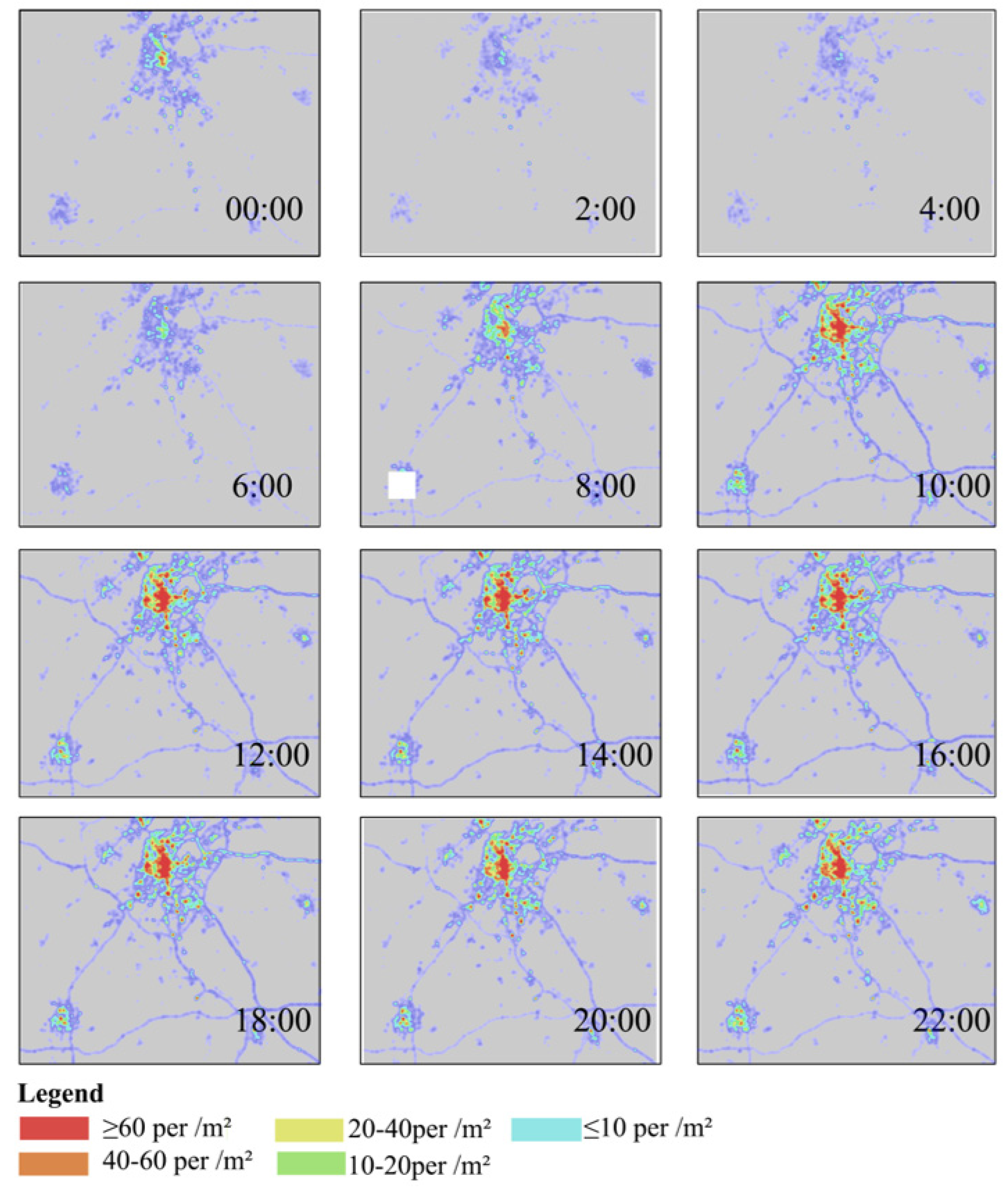
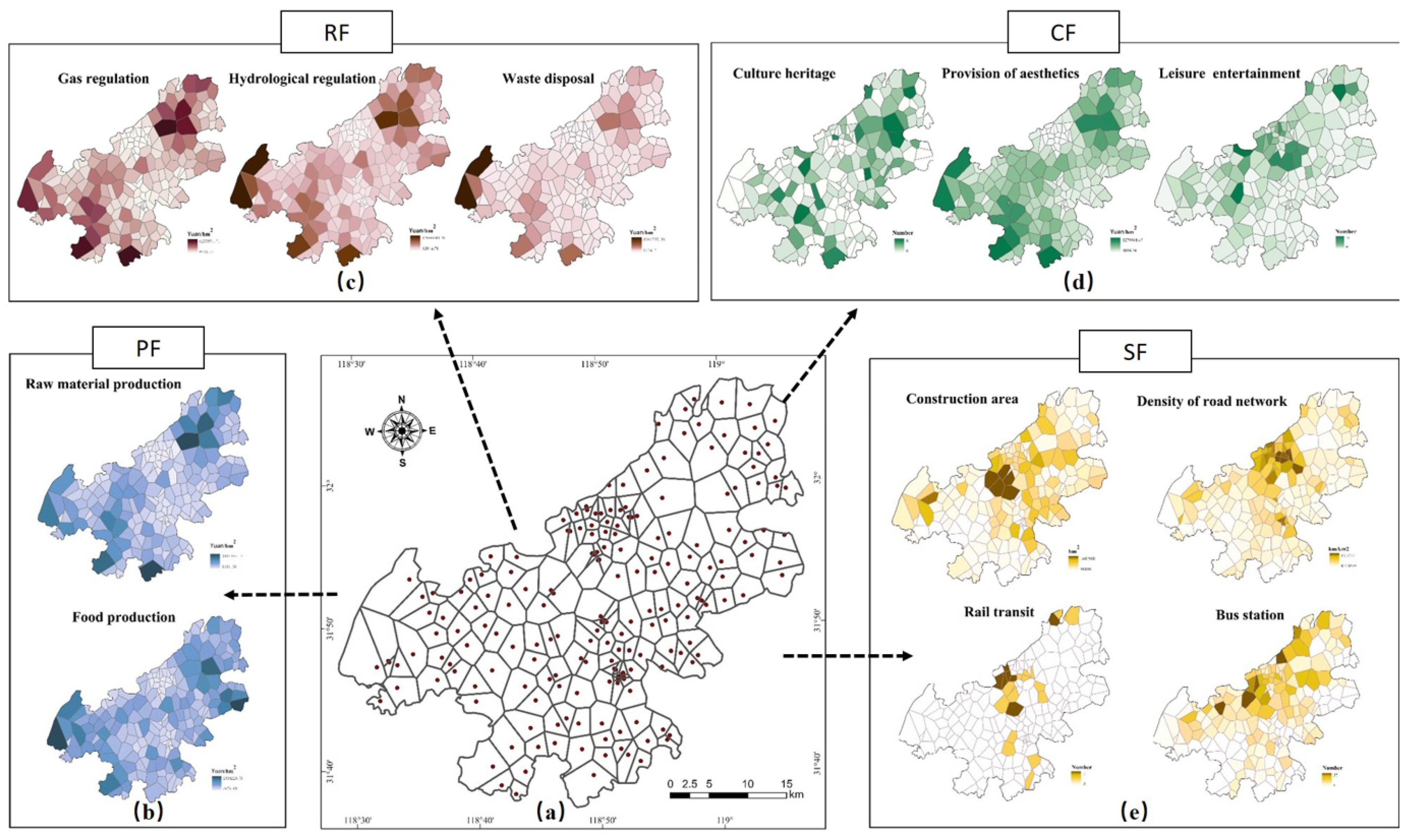
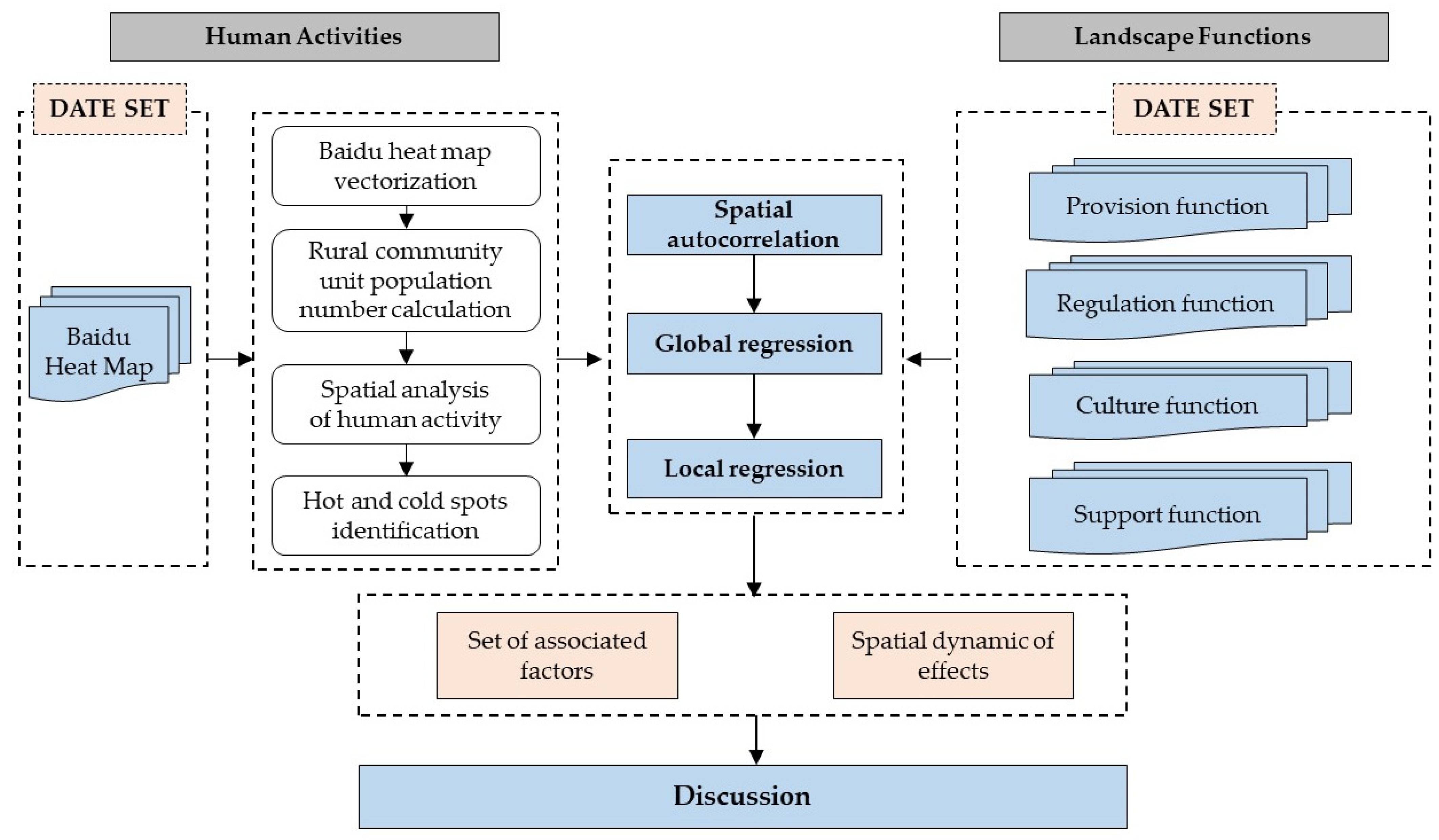
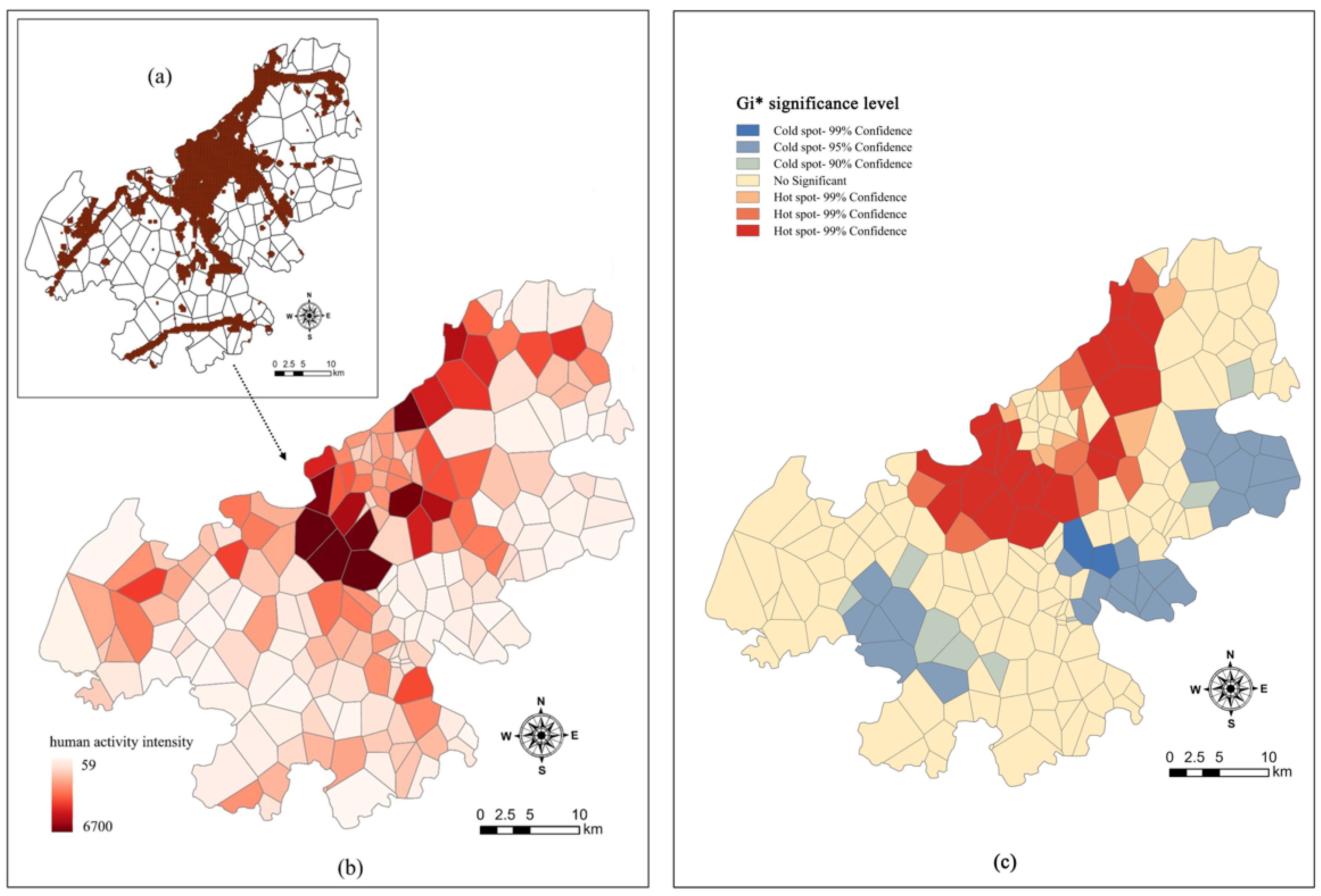
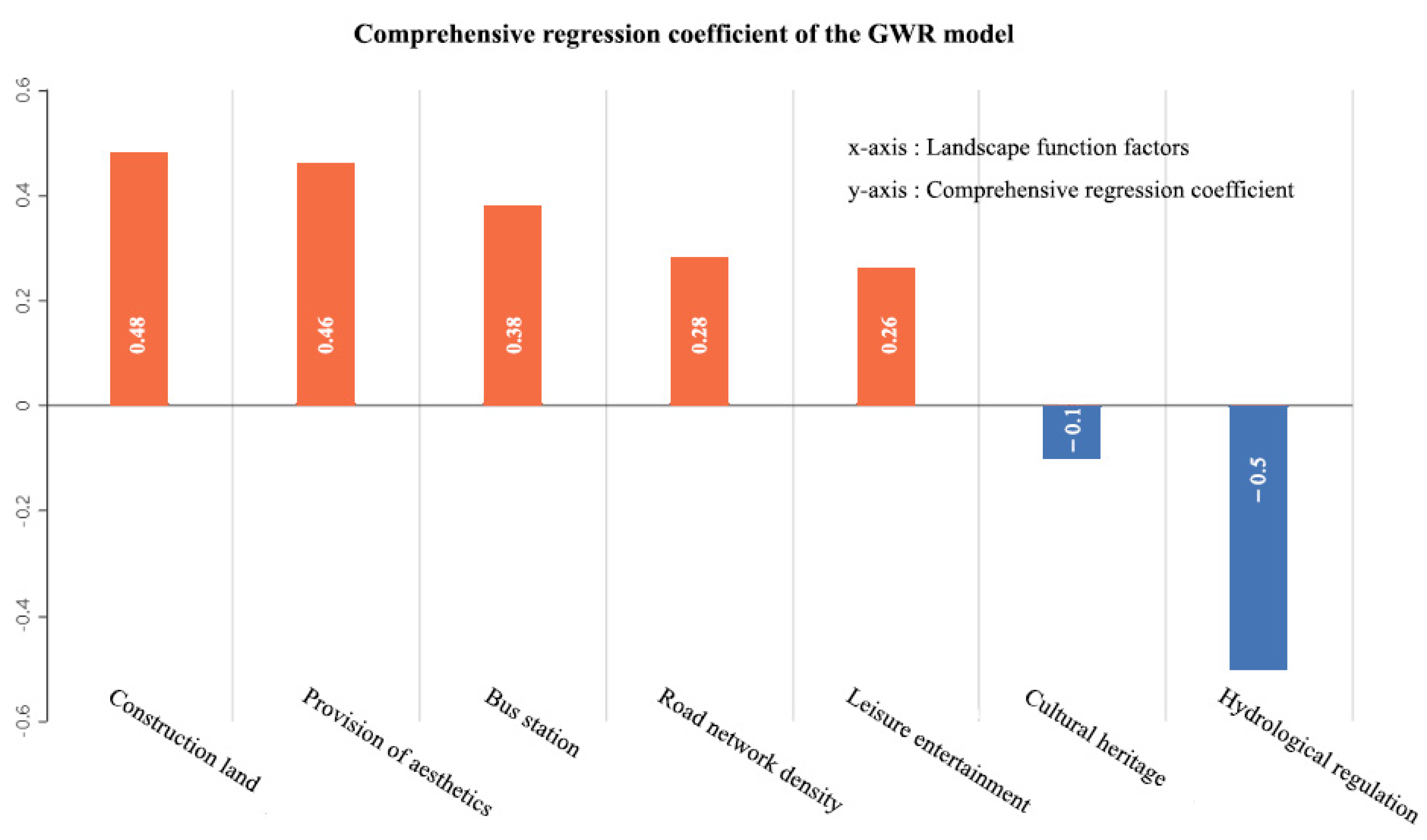
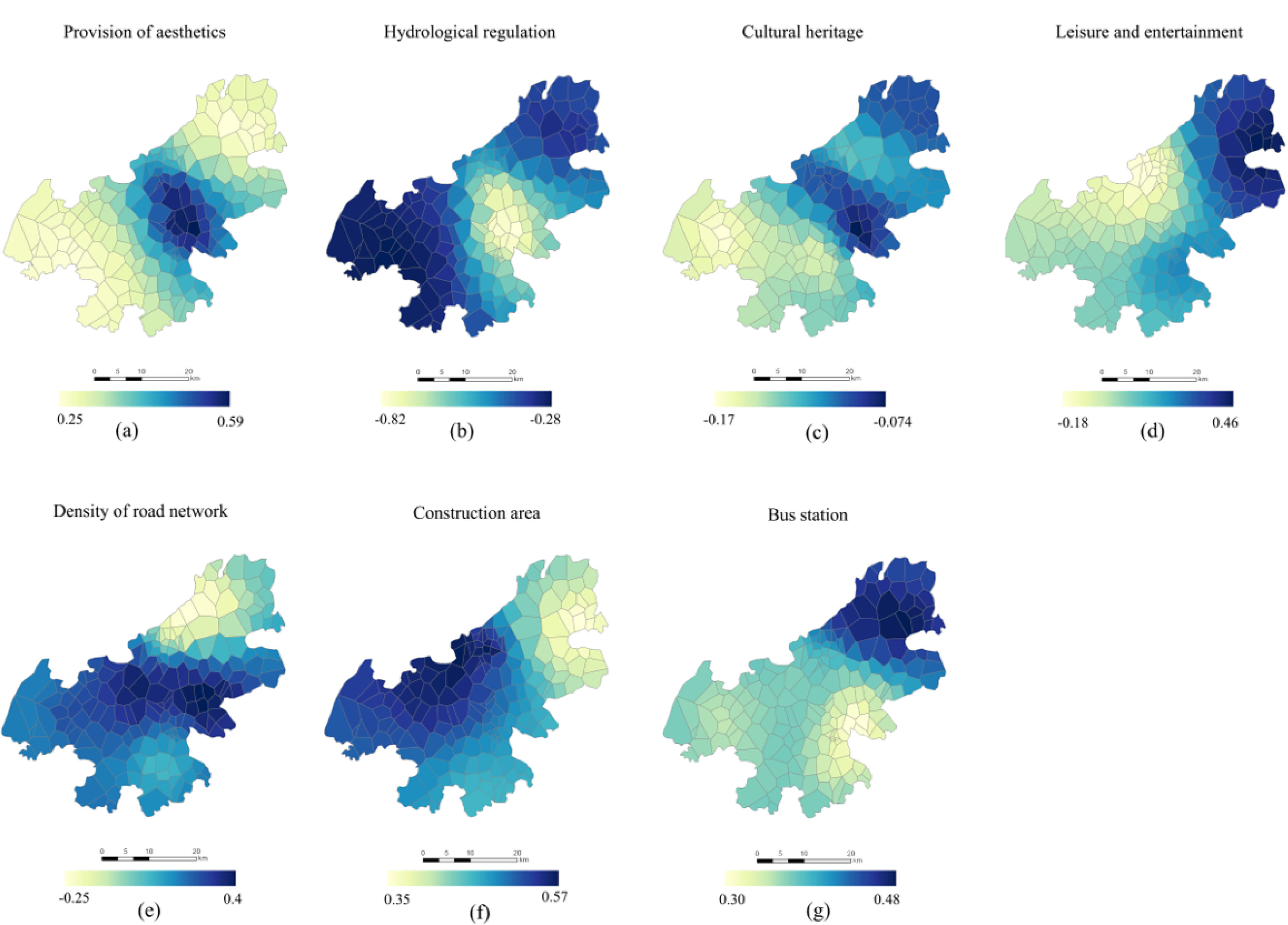
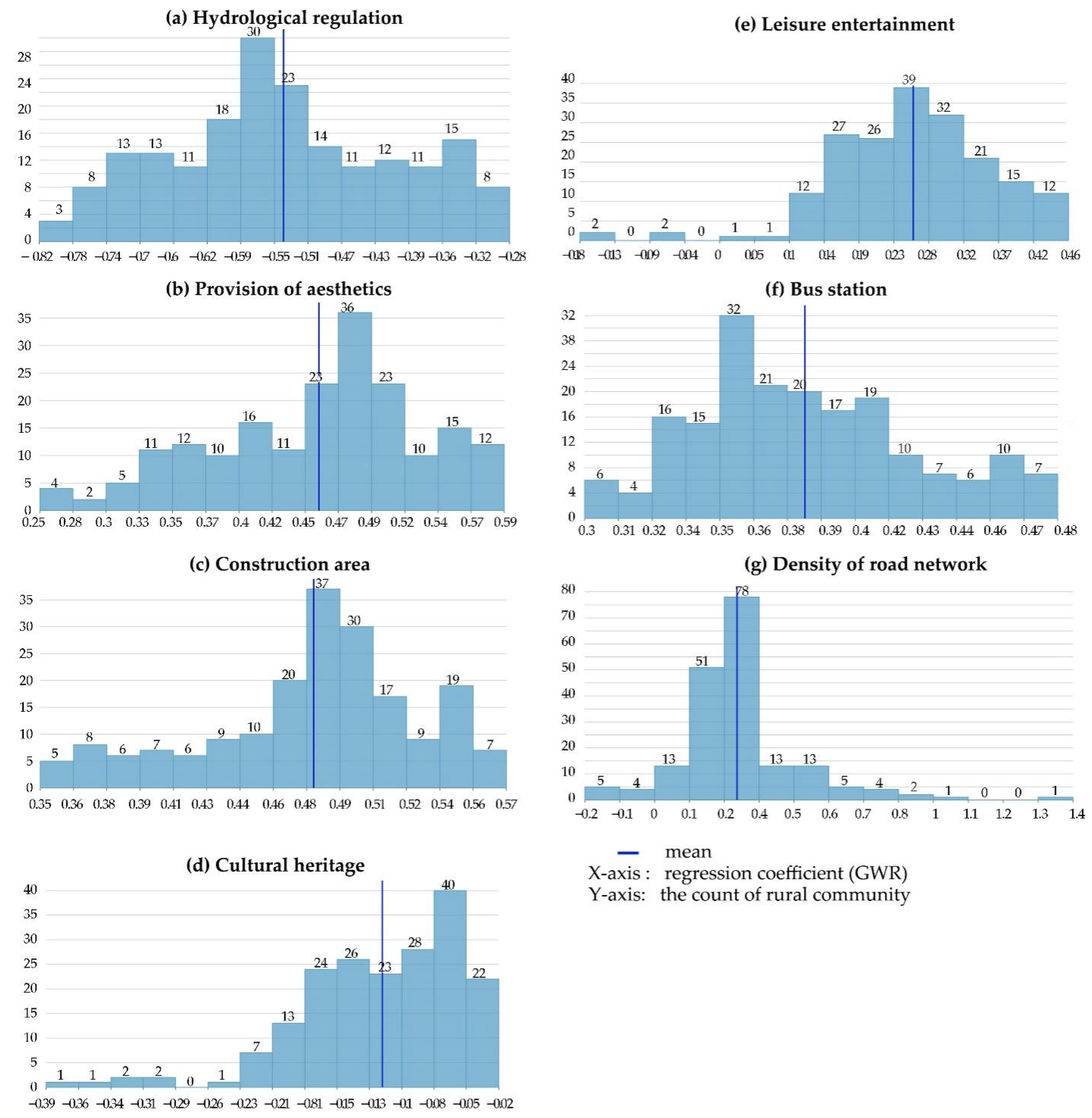
| Level-I Type | Level-II Type | Description |
|---|---|---|
| Provision function (PF) | Food production | Converting solar energy into edible plant and animal products |
| Raw material production | Converting solar energy into biological energy for building or other purposes | |
| Regulating function (RF) | Gas regulation | The ecosystem maintains the balance of atmospheric chemical components, absorbing SO2, fluorides, and nitrogen oxides |
| Hydrological regulation | The freshwater filtration, retention, and storage by the ecosystem, as well as the supply of freshwater | |
| Waste disposal | The role of vegetation and organisms in the removal and decomposition of excess nutrients and compounds; dust trapped | |
| Culture function (CF) | Provision of aesthetics | Landscapes (potentially) available for entertainment, and valuable in terms of culture and arts |
| Cultural heritage | Immovable cultural relics of great historical, artistic, and scientific value. | |
| Leisure entertainment | Tourist spots offering leisure and entertainment | |
| Support function (SF) | Transport function | Accessibility mapping(density of road network, bus station, and rail transit) |
| Construction function | The ability to provide humans with living and working spaces |
| Variable | Moran I | p | z | Variable | Moran I | p | z |
| Human activities | 0.47 | 0.00 | 9.83 | Hydrological regulation | 0.32 | 0.00 | 7.04 |
| Road network density | 0.67 | 0.00 | 13.96 | Gas regulation | 0.42 | 0.00 | 8.79 |
| Bus station | 0.41 | 0.00 | 8.56 | Raw material production | 0.39 | 0.00 | 8.23 |
| Rail transit | 0.33 | 0.00 | 7.03 | Food production | 0.51 | 0.00 | 10.54 |
| Cultural heritage | 0.13 | 0.00 | 2.84 | Provision of aesthetics | 0.42 | 0.00 | 8.80 |
| Leisure entertainment | 0.21 | 0.00 | 4.53 | Construction area | 0.31 | 0.00 | 6.45 |
| Waste disposal | 0.24 | 0.00 | 5.56 |
| Explanatory Variables | Coefficient | StdError | t-Value | p-Value | VIF | |
|---|---|---|---|---|---|---|
| Model 1 | Waste disposal | −10.993 | 2.306 | −4.766 | 0.000 * | 848.645 |
| Hydrological regulation | −12.110 | 2.591 | −4.674 | 0.000 * | >1000 | |
| Gas regulation | −2.607 | 0.944 | −2.763 | 0.000 * | 396.959 | |
| Raw material production | −0.383 | 0.505 | −0.758 | 0.045 | 90.674 | |
| Food production | −1.300 | 0.263 | −4.934 | 0.000 * | 26.989 | |
| Provision of aesthetics | 1.228 | 0.377 | 3.252 | 0.000 * | 70.791 | |
| Construction land | 0.572 | 0.074 | 7.716 | 0.000 * | 2.226 | |
| Road network density | 0.100 | 0.064 | 1.572 | 0.060 | 2.610 | |
| Bus station | 0.336 | 0.069 | 4.890 | 0.000 * | 2.328 | |
| Rail transit | 0.000 | 0.043 | 0.008 | 0.996 | 1.340 | |
| Cultural heritage | −0.102 | 0.053 | −1.931 | 0.084 | 1.227 | |
| Leisure entertainment | 0.308 | 0.063 | 4.877 | 0.000 * | 1.250 | |
| R 2 | 0.732 | |||||
| Adjust R 2 | 0.712 | |||||
| F | 40.103 | |||||
| Sig. | 0.000 | |||||
| Model 2 | Hydrological regulation | −0.365 | 0.152 | −2.405 | 0.017 * | 4.707 |
| Provision of aesthetics | 0.341 | 0.109 | 3.109 | 0.002 * | 5.344 | |
| Construction area | 0.450 | 0.071 | 6.367 | 0.000 * | 1.807 | |
| Road network density | 0.226 | 0.600 | 3.787 | 0.000 * | 2.060 | |
| Bus station | 0.394 | 0.071 | 5.524 | 0.000 * | 2.240 | |
| Cultural heritage | −0.115 | 0.553 | −2.092 | 0.037 * | 1.203 | |
| Leisure entertainment | 0.299 | 0.064 | 4.652 | 0.000 * | 1.163 | |
| R 2 | 0.692 | |||||
| Adjust R 2 | 0.678 | |||||
| F | 50.836 | |||||
| Sig. | 0.000 | |||||
| AIC | 269.45 | |||||
| Koenker (BP) | 16.125181 * (p = 0.040) | |||||
| R2 | AdjR2 | AICc | Sigma-Squared MLE |
|---|---|---|---|
| 0.806 | 0.750 | 242.4 | 0.009 |
Publisher’s Note: MDPI stays neutral with regard to jurisdictional claims in published maps and institutional affiliations. |
© 2021 by the authors. Licensee MDPI, Basel, Switzerland. This article is an open access article distributed under the terms and conditions of the Creative Commons Attribution (CC BY) license (https://creativecommons.org/licenses/by/4.0/).
Share and Cite
Zheng, J.; Chen, G.; Zhang, T.; Ding, M.; Liu, B.; Wang, H. Exploring Spatial Variations in the Relationships between Landscape Functions and Human Activities in Suburban Rural Communities: A Case Study in Jiangning District, China. Int. J. Environ. Res. Public Health 2021, 18, 9782. https://doi.org/10.3390/ijerph18189782
Zheng J, Chen G, Zhang T, Ding M, Liu B, Wang H. Exploring Spatial Variations in the Relationships between Landscape Functions and Human Activities in Suburban Rural Communities: A Case Study in Jiangning District, China. International Journal of Environmental Research and Public Health. 2021; 18(18):9782. https://doi.org/10.3390/ijerph18189782
Chicago/Turabian StyleZheng, Jie, Guodong Chen, Tiantian Zhang, Mingjing Ding, Binglin Liu, and Hao Wang. 2021. "Exploring Spatial Variations in the Relationships between Landscape Functions and Human Activities in Suburban Rural Communities: A Case Study in Jiangning District, China" International Journal of Environmental Research and Public Health 18, no. 18: 9782. https://doi.org/10.3390/ijerph18189782
APA StyleZheng, J., Chen, G., Zhang, T., Ding, M., Liu, B., & Wang, H. (2021). Exploring Spatial Variations in the Relationships between Landscape Functions and Human Activities in Suburban Rural Communities: A Case Study in Jiangning District, China. International Journal of Environmental Research and Public Health, 18(18), 9782. https://doi.org/10.3390/ijerph18189782








